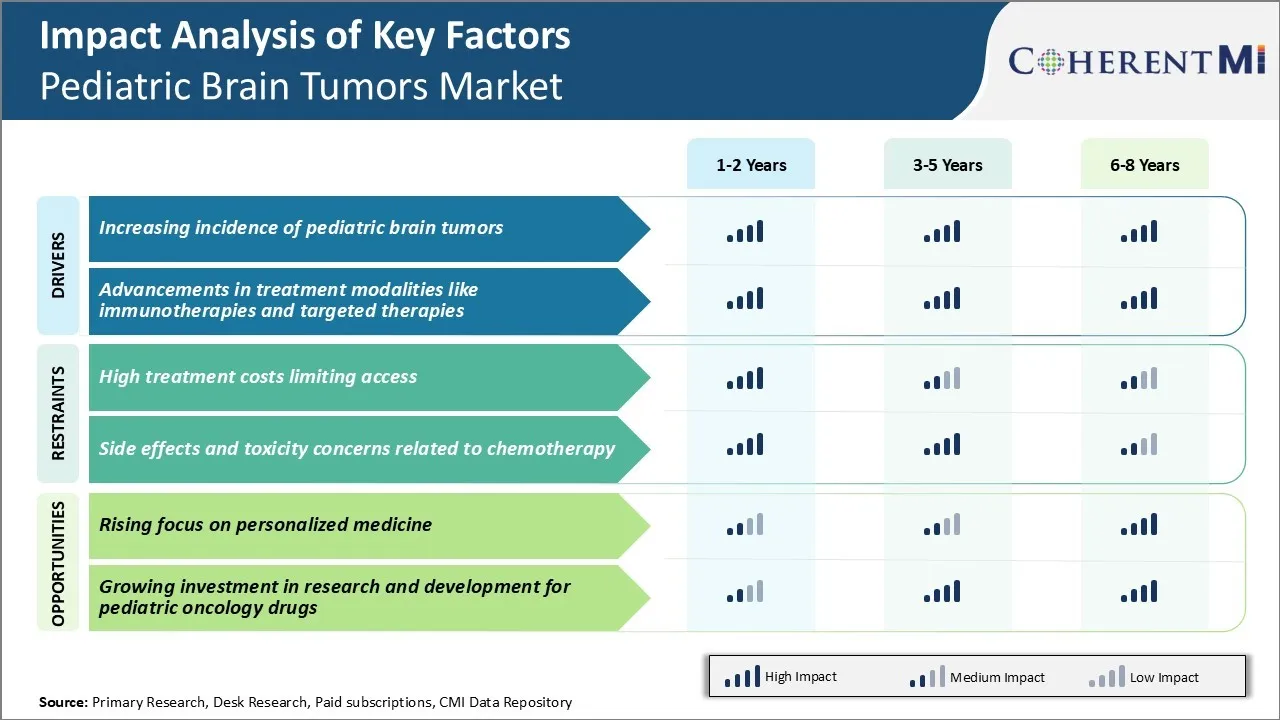小児脳腫瘍市場 規模およびシェア分析 - 成長トレンドおよび予測 (2024 - 2031)
小児脳腫瘍市場は、治療(手術、化学療法、放射線療法、標的療法)、腫瘍(神経膠腫、髄芽腫、胎児性腫瘍、松果体腫瘍)、患者期間(小児、青年)、地域(北米、ラテンアメリカ、アジア太平洋、ヨーロッパ、中東、アフリカ)別に区分されています。レポートでは、上記の価値(10億米ドル単位)を提示しています。....
小児脳腫瘍市場 サイズ
市場規模(米ドル) Bn
CAGR6.9%
| 調査期間 | 2024 - 2031 |
| 推定の基準年 | 2023 |
| CAGR | 6.9% |
| 市場集中度 | High |
| 主要プレーヤー | ノベルティ, パフィイザー, バイエル, ブリストル・マイアーズ・スクイブ, エリ・リリーと会社 その他 |
お知らせください!
小児脳腫瘍市場 分析
小児脳腫瘍の市場は、評価されると推定される 2024年のUSD 1.55 Bn そして到達する予定 2031年までのUSD 2.47 Bn, 化合物の年間成長率で成長 ()2024年から2031年にかけて6.9%のCAGR。 遺伝子リスク要因や環境暴露による小児脳がんの蔓延が市場を牽引しています。 小児がんの治療と高度な治療オプションの開発に費やすライジング医療は、小児脳腫瘍の市場を燃やすこともできます。
小児脳腫瘍市場 トレンド
市場ドライバー - 小児脳腫瘍の増加
小児脳腫瘍の市場の主要なドライバーの1つは、小児脳および中枢神経系(CNS)腫瘍のさまざまな形態の発生率が高まっています。 CNS腫瘍は小児では比較的まれですが、小児がんの20%未満を占める一方で、最近の研究では、その発生率が徐々に増加しています。 米国単独では、小児脳およびCNS腫瘍の4,500を超える新しい症例が推定に応じて毎年診断されます。
脳腫瘍は、特に若い年齢で発生する複雑な神経発達による小児の治療に困難です。 子宮筋腫、天体細胞腫および肺腫などの一般的な小児脳腫瘍の生存率は10年以上にわたって改善されてきましたが、これらの癌は依然として考えられる課題を提示しています。
手術や化学療法などの治療を成功させた後でも、長期生存者は、副作用や機能障害を悪化させることがよくあります。 これは、子供、家族、医療システムに密接な緊張を置き、より効果的で新しい治療の必要性を促進します。
小児がん研究に重点を置いた各種基礎と非営利団体は、資金調達キャンペーンや患者支援プログラムを通じて、この分野における未知のニーズについても意識を上げています。
市場ドライバー - 免疫療法やターゲティング療法などの治療方法の進歩
継続的な進歩は、継続的な研究の努力を借りて小児脳癌の管理で行われています。 市場の可能性を拡張する主要なドライバーの1つは、免疫療法や標的療法などの治療方法で発生する進歩です。
免疫チェックポイント阻害剤は、腫瘍細胞に対する体自身の免疫反応を解明するのに役立ちますが、グリオームのような特定の小児脳腫瘍の臨床試験で早期の約束を示しています。 これらの薬剤は慣習的な化学療法のレジメンと比較される少数の副作用とよりターゲットを絞られた処置のための潜在性を提供します。
腫瘍固有の遺伝子変異と成長因子の受容体を標的とするいくつかの標的療法はパイプラインにあります。 FDAの小児科の使用のために既に承認されたか、またはブレークスルーの指定を受けました。 脆弱な分子経路を攻撃する彼らの相対的な精度は、担保的な損傷から健康な組織をスパリングしながら、改善された効力を期待しています。 また、必要に応じて注入や注射を介した代わりに経口投与することもできます。
患者のユニークな腫瘍プロファイルに基づく精密薬およびパーソナライズされた治療の分野は、この領域で医薬品研究開発にさらなるブーストを与えています。

市場チャレンジ - 高処理コスト制限アクセス
小児脳腫瘍市場で直面する主要な課題の1つは、多くの若い患者のために質の高い医療へのアクセスを制限する治療の高コストです。 小児脳腫瘍の治療は、手術、化学療法、放射線療法、免疫療法などのさまざまな治療方法を含む長期および複雑なプロセスです。 これらの高度な治療オプションはすべて、すべての家族が余裕がない非常に高い価格で提供されます。
様々な研究によると、米国の小児脳腫瘍の治療の平均コストは、腫瘍の種類と段階に応じて10万ドルから50万ドルの範囲です。 多くの家族、特に未経験者、または未熟な人、そして子供の治療とケアの全過程で支払うことは非常に困難であることを意味します。
高コストは、家族が推奨される治療プロトコルの遅延またはオプトアウトを強制することが多いです。 これは、最終的に低所得の背景から小児脳腫瘍の患者の健康結果と予後に影響を与える。 手頃な価格とアクセシビリティの問題に対処することは、社会のすべての社会経済的セクションにわたって小児脳腫瘍患者の生存率と生活の質を向上させることが不可欠です。
市場機会 - パーソナライズされた医療に焦点を当てる
小児脳腫瘍市場で入手可能な主要な機会の1つは、パーソナライズされた医薬品に焦点を当てています。 癌遺伝学や分子生物学などの分野における進歩により、医学研究者は、さまざまな遺伝子、分子、生物学的要因の異なる種類の小児脳腫瘍を根ざした理解を深めています。 この成長する知識は、個々の若い患者のユニークなプロファイルとニーズに合わせてカスタマイズされた治療アプローチの開発を可能にします。
パラダイムは、子供の腫瘍遺伝学、バイオマーカー表現、その他の個々の特性に基づいてパーソナライズされたレジメンに1つのサイズのフィットから徐々にシフトしています。 パーソナル化医療は、より安全で効果的な標的薬、免疫療法および他の治療戦略を開発するための可能性を開きます。
また、ヘルスケアプロバイダーは、リスクを予測し、スクリーニング方法を調整し、各小児脳腫瘍症例の最も最適な治療経路を選択することにより、より詳細な決定を下すことができます。 パーソナライズされた治療に対する上昇の焦点は、健康的結果を改善し、副作用を最小限に抑え、将来の小児脳腫瘍患者のための生活の質を高めるために莫大な可能性を保持しています。
処方者の好み 小児脳腫瘍市場
ほとんどの小児脳腫瘍のための標準的な第一線の処置は放射線療法によって続いて外科です。 腫瘍の種類、場所、段階に応じて化学療法も使用できます。 最も一般的なタイプである低グレードのastrocytomasのために、シリアルMRIモニタリングによるクローズ観察は、初期段階で即時の治療に優先されます。 カルバマゼピン(Tegretol)などの経口薬を使用して単独で化学療法は十分かもしれません。
グレードの高いグローマの場合、最も積極的な腫瘍は、優先される第一線治療には、テモゾロマイド(Temodar)を使用して化学療法による最大の外科的切除が含まれます。 これは、放射線単独と比較して、進行なしおよび全体的な生存を改善するために示されています。 再燃した腫瘍のために、処方者は静脈内ロムスチン(CeeNU)またはイリノテカン(Camptosar)を使用して化学療法を支持する。 また、化学療法後の統合療法として、自己免疫幹細胞移植もますます用いられています。
子供の年齢、大きさ、腫瘍の場所、および外科的リスクなどの他の要因も決定に影響を及ぼします。 処方者は、小児患者にとって重要な考慮事項である神経認知の欠乏のような長期的副作用を最小限に抑えて、生存利益の最大化のバランスをとります。 全体的な処置の目的は生命の質の保存の長期病気制御を含んでいます。
治療オプション分析 小児脳腫瘍市場
小児脳腫瘍は、腫瘍の大きさ、場所、およびそれが広がるかどうかなどの要因に基づいて異なる段階に分類することができます。 初期段階は、転移していない局所性腫瘍を含む。 ここで最も一般的な治療は、手術、放射線療法および化学療法です。
手術のために、目標は、できるだけ安全に腫瘍の多くを取り除くことです。 これは、腫瘍の負担を直接軽減し、正確な診断のために組織を取得します。 放射線療法は、がん細胞を破壊するために高エネルギーX線を使用し、場所の手術では安全にアクセスできません。 手術と一緒によく使われます。
Chemotherapyはボディを通して癌細胞に達するために薬剤を使用します。 カルボプラチンやビンクリスチンのような薬は、一般的に単独または低度の腫瘍のための組み合わせで使用されます。 より積極的な癌のために、カルボプラチン、ビンクリスチンおよびロムスチンの組合せは好まれます。 これらのマルチドラッグレジメンは、小児患者の臓器機能を維持しながら、より高い腫瘍反応率を示しています。
がんが脳や脊髄の他の部分に転移する場合、先進的な段階と見なされます。 ここでは、幹細胞移植に続く高用量化学療法は、受容不能な毒性なしで化学療法の高い用量を提供するためのケアの基準です。 テモゾロミド、シスプラチンのような薬は、放射線療法と組み合わせて一般的に使用されます。
主要プレーヤーが採用した主な勝利戦略 小児脳腫瘍市場
標的療法の開発の焦点: : : Amgen、Novocure、Brist-Myers Squibbなどの企業によって採用される主要な戦略の1つは、小児脳腫瘍の治療結果を向上させることができる標的療法を開発することに焦点を当てています。 たとえば、Amgen は、2012 年に再発性小児性グリオーマに対して、VEGF ターゲット療法である Bevacizumab (Avastin) を開発しました。
パートナーシップとコラボレーション: 企業は、戦略的パートナーシップと学術機関とのコラボレーションを積極的に追求し、専門知識、患者の人口にアクセスし、R&Dのリスク/コストを共有します。 たとえば、ノボクアは、セント・ジュード・チャイルド・チャイルド・リサーチ・病院などの小児脳腫瘍研究センターと連携し、オプチューン臨床試験を実施しました。
免疫療法の研究に投資: 大人の脳腫瘍で有望な結果を与える, 選手はますます小児のための免疫療法のアプローチを調査しています. ブリストル・マイアーズ・スクイブは、ニヴォルマブ単独の免疫チェックポイント阻害薬を評価しているいくつかのフェーズ1/2臨床試験を実行しているか、リカレント小児科の高学位グリオマとの組み合わせで 2017.
地理的拡張: : : 主要なプレーヤーは承認されたプロダクトの地理的な拡大を運転するために国際市場でのローカル ディストリビューターとパートナーします。 例えば、2015年米国FDAの承認後、ノボキュアは、オプチューンを主要ヨーロッパ市場と日本に2017-18年までに現地のパートナーシップを結びました。 これにより、患者のアクセスと収益が増加することができました。
セグメント分析 小児脳腫瘍市場
洞察、治療による:外科的進歩 ドライブより高い採用
治療の面では、手術は2024年に小児脳腫瘍市場の41.6%のシェアを占め、外科的技術と技術の継続的な改善に専念しています。 多くの小児脳腫瘍のために、外科的切除は処置の基礎を残します。 術内MRI、高度な神経ナビゲーションシステム、超音波吸引装置、およびレーザー間接熱療法などの進歩により、肝機能を維持しながら、腫瘍の質量の多くを除去するための外科医が有効な。 これは、低グレードのグリマや特定の中線腫瘍などの条件のための臨床結果を改善するために翻訳しました。
最大の切除を超えて、外科はまた正確な診断および腫瘍の等級分けのために必要なティッシュの見本抽出のための機会を提供します。 このステージング情報は、その後のセラピーの最も効果的な組み合わせを決定するために重要です。 ベントリカルオペラ座の支所、視覚神経の外装のfenestrationのような付加的なプロシージャおよびcerebrospinalの液体の多様化は関連問題に取り組むために同じ外科の間に一般に行われます。
外科的スキルと支持技術が進むにつれて、切除の許容範囲が再定義されています。 以前、分裂性内分泌尿器グリマなどの操作不能と見なされた特定の非常に侵襲的な腫瘍タイプは、積極的な外科的試験の対象となります。 組織の専門知識は、小児神経腫瘍学に焦点を当てたフェローシップと専門トレーニングプログラムによって育種しています。 最小限の侵襲的な内視鏡技術の広まった採用は回復を高めます。 これらすべての要因は、初期管理の最前線で手術の役割を果たします。

洞察力, 腫瘍によって: 拡散の性質によるGliomas Dominate
腫瘍の面では、グリオマは、2024年の市場での48.7%のシェアを保持するために投じられ、それらの潜在的成長パターンを与えられます。 すべての小児脳腫瘍の約25-30%を占める。 低グレードのグローマは、特にポンとサラムス地域では一般的であり、高級な形態は生存率が悪い。 外科的にアクセス可能なローカライズされたマッサージとは異なり、グリマは、脳パレンチマ全体に多焦点指を拡張します。 最大の安全切除でも、残留顕微鏡病は完全に除去することがほぼ不可能です。
この拡散形態は、化学療法の重要な役割をサポートし、隣人およびneoadjuvant戦略として標的療法の重要な役割を担います。 第一線のアルキル化剤であるTemozolomideは、進行のない生存を拡張し、頻繁に放射線と結合する有意義な利点を示します。
カルムスチンウエファー、ベバシズマブ、セルメチニブなどの実験標的薬は、特定の分子腫瘍サブクラスに対する約束を示す。 Ongoingの研究は小児科の塗布に抗angiogenicおよび免疫のチェックポイントの抑制剤の大人の発見を翻訳することを目指しています。 さらに、包括的なゲノム分析は、将来の医薬品ターゲットとして役立つ可能性のある新しいゲノム変化を克服しています。 全体的に、系統的なモダリティの積極的な活用は、グローマスのinfiltrative成長パターンのために必要ままです。
洞察, 患者の年齢によって: 青年ケアは大人の提供者に移行を強調します
忍耐強い年齢の面では、小児セグメントは現在最も高いシェアに貢献します。 しかしながら、大人のケアシステムへのスムーズな移行を確保するために、青年患者の焦点が高まっています。 これらの定形年の間に診断された脳腫瘍は、ユニークな発達、心理社会的および医学的問題を示す。 青年は、成長する独立性をナビゲートします, 関係を変えます, 教育/介護者計画, 不妊の懸念や保険は、生涯監視を必要とする複雑な多変性がんの治療と同時変化.
成功したモデルは、自己管理スキル、心理腫瘍サポート、セクシュアリティカウンセリング、小児および成人プロバイダ間の調整ケアを強調しています。 移行プログラムは、臨床情報を転送し、サブ・スペシャリティ・フォローアップを調整し、セルフ・アドボカシーのスキルを育成することを目的としています。 子どもの生活の専門家と十代のフレンドリーな空間を欠かせる大人の施設をナビゲートして課題を解決します。
小児科の環境を損なうと、深刻な検査と健康維持が特に脆弱であることが認められています。 家族中心の移行サポートの全体的な重点は、この脆弱なグループのための成人期の結果で約束を示しています。 小児脳腫瘍ケアにおける品質向上の積極的な領域は残っています。
追加の洞察 小児脳腫瘍市場
- 小児脳腫瘍は、すべての小児癌のほぼ20%を占め、最も一般的にはグリマである。 これらのがんは、先進医療インフラの欠如による低所得地域における課題を、先進国ではますますます増加しています。
- 小児脳腫瘍は、すべての小児癌の約20%を表します。
- 生存率は、5年生存率が約75%の低学年腫瘍で変化し、高学年腫瘍の有意な低下率です。
競合の概要 小児脳腫瘍市場
小児脳腫瘍市場で動作する主要なプレーヤーは、Novatis、Pfizer、Bayer、Bristol-Myers Squibb、Eli Lilly、Company、Biodexa Pharmaceuticals、Cellectar Biosciences、およびMidatech Pharmaを含みます。
小児脳腫瘍市場 リーダー
- ノベルティ
- パフィイザー
- バイエル
- ブリストル・マイアーズ・スクイブ
- エリ・リリーと会社
小児脳腫瘍市場 - 競合関係

小児脳腫瘍市場
(大手プレーヤーが支配)
(多くのプレーヤーが参入し、競争が激しい。)
最近の動向 小児脳腫瘍市場
- 2024年6月、Pfizerは、小児患者における高級グリマの治療を目的とした新しい免疫療法薬を導入し、特定の腫瘍タンパク質を標的することにより生存率を高めることが期待されています。 Pfizerは脳がん研究を含む腫瘍学に積極的に関与しています。
- ノバルティスは、2023年3月、第II相/第III相TADPOLE試験の有望な結果を発表しました。これは、タフィンラー(dabrafenib)とメキニスト(トラメチニブ)を用いた標的療法の有効性を評価しました。低グレードのグローマ(LGG)は、BRAF V600E変異を運びます。 この組み合わせ療法は、化学療法で治療された患者のわずか11%と比較して、47%の全体的な応答率を示す、大幅に腫瘍サイズを低下させました。
2020年7月、ブリストル・マイアーズ・スクイブは、再発性medulloblastomaを治療するために設計された免疫療法薬のFDA承認を受け、患者に対する新しい治療ラインを提供しました。 ブリストル・マイアーズ・スクイブは、ニヴォルマブ(Opdivo)とイピリムマブ(Yervoy)を含む組み合わせ治療の承認を含む、癌治療のためのいくつかのFDAの承認を受けていますが、これらは、メデュロブストマではなく、非小細胞肺癌やリンパ腫などの他の癌に焦点を当てました。
小児脳腫瘍市場 セグメンテーション
- 治療によって
- 外科手術
- 化学療法
- 放射線療法
- ターゲット療法
- チューモ
- グリオマス
- Medulloblastomas(メドゥロブストマ)
- 名誉腫瘍
- パイン地域腫瘍
- 患者の時間によって
- 小児科
- アドルセント

購入オプションを検討しますか?このレポートの個々のセクション?
よくある質問 :
小児脳腫瘍の市場はどれくらいの大きさですか?
小児脳腫瘍の市場は2024年にUSD 1.55 Bnで評価され、2031までにUSD 2.47 Bnに達すると予想されます。
小児脳腫瘍市場の成長を妨げる重要な要因は何ですか?
化学療法に関連するアクセスと副作用と毒性の懸念を制限する高処理コストは、小児脳腫瘍市場の成長を妨げる主要な要因です。
小児脳腫瘍の市場成長を促進する主要な要因は何ですか?
免疫療法や標的療法などの治療薬の小児脳腫瘍および増殖の増加は、小児脳腫瘍の市場を運転する主要な要因です。
小児脳腫瘍市場での主な治療法は何ですか?
主要な処置の区分は外科です。
小児脳腫瘍市場で動作する主要な選手はどれですか?
Novartis、Pfizer、Bayer、Bristol-Myers Squibb、Elily and Company、Biodexa Pharmaceuticals、Cellectar Biosciences、およびMidatech Pharmaは主要なプレーヤーです。
小児脳腫瘍市場のCAGRは何ですか?
小児脳腫瘍市場でのCAGRは、2024-2031から6.9%になるように計画されています。